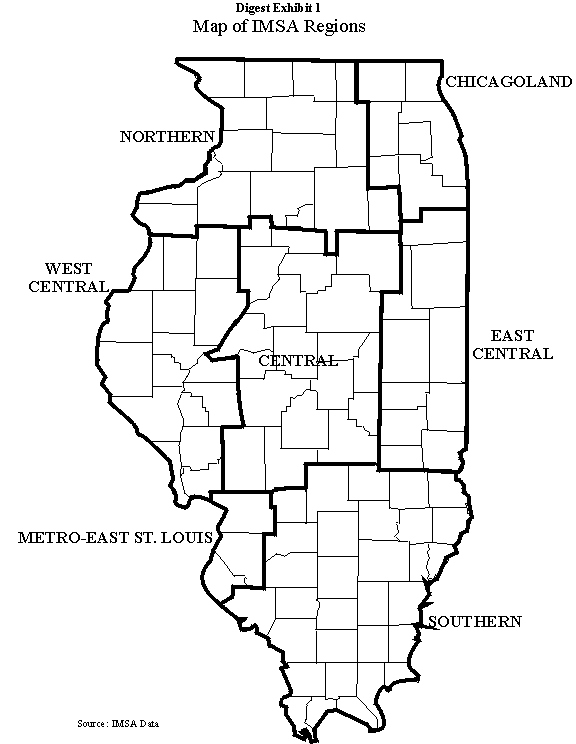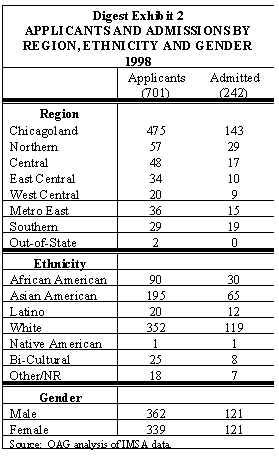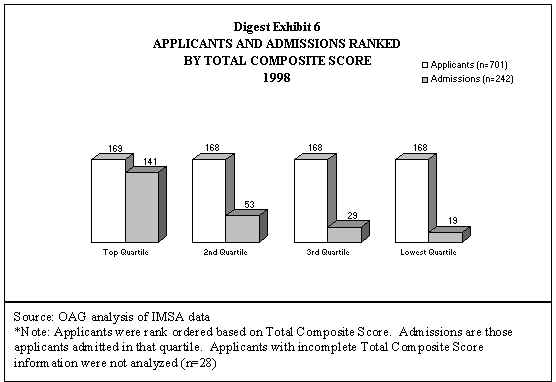REPORT CONCLUSIONS
Illinois Mathematics and Science Academy (IMSA) was
created by Public Act 84-126 in 1985. IMSA is a residential school serving 10th
– 12th graders. State law states that the primary role of the Academy is
to offer a uniquely challenging education for students talented in the areas of
mathematics and science. Legislative Audit Commission Resolution Number 115 directed the
Auditor General to conduct a management and program audit of IMSA’s admissions
process.
IMSA has written admissions policies and procedures and an
extensive admissions process which is used to select each 10th grade class.
IMSA’s admissions process was originally approved by the Board of Trustees in 1986
when the Academy opened. Since the Academy opened, IMSA’s admissions practices have
been modified; however, the formal policy was not updated and approved by the IMSA Board
of Trustees until January 1999. Therefore, IMSA’s actual admissions practices have
deviated from Board of Trustees’ approved policy for a number of years.
IMSA automatically selects the applicants with the highest
total composite scores (which includes applicant’s GPA, SAT I, and Review Committee
Rating) to comprise the first half of the admitted class. The second half of the class is
selected using additional factors, including geographic, gender, and ethnic criteria.
An IMSA official stated that the ultimate goal of the
selection process is to have admissions which approximate the demographics of the State;
some IMSA directives also state that as its goal. However, IMSA’s admissions policy
directs that admissions reflect the diversity of the applicant pool. IMSA’s applicant
pool, mainly in the area of ethnicity, is not representative of statewide demographics.
Many key terms used in the current admissions process are
not defined in the newly approved policy. In addition, many of the criteria used during
the selection of the second half of the class are not clearly outlined in policy.
A three-year history of IMSA admissions in terms of
geographic and gender distributions shows that, while there is some variation, the
applicant pool is generally consistent with the statewide distribution of 9th
graders and with the invited class. The ethnic distribution has the most variation when
compared to the statewide population of 9th graders. Over the three years
reviewed, African Americans and Latinos were consistently underrepresented in the
applicant pool and in the invited class when compared to the number of African American
and Latino 9th graders in the State. Conversely, Asian Americans were
consistently overrepresented in both the applicant pool and the invited class when
compared to the percent of Asian American 9th graders in the State.
One result of IMSA’s attempt to comply with its
statutory requirement to admit a class with adequate geographic, ethnic and gender
representation is that applicants with lower total composite scores are admitted to IMSA
in the second half of the class over applicants with higher scores but whose demographics
are adequately represented. The total composite score is a computed score that is a
combination of 1/3 GPA, 1/3 SAT I, and 1/3 Review Committee Rating.
For example, in 1998, 143 applicants in the upper half of
the applicant pool based on total composite score were not admitted, whereas 48 applicants
in the lower half of the applicant pool were admitted. However, only 4 of the 45 (9
percent) students admitted to IMSA as one of the last 10 based on total composite score in
each of the past five years were sent home for academic reasons. Overall, these 45
students’ retention rate was 78 percent compared to IMSA’s retention rate of 88
percent over the past five years.
IMSA has outreach programs to attract qualified candidates
interested in the Academy. IMSA conducted outreach programs in all seven of its regions.
In 1997/1998, IMSA held informational meetings in 53 locations across the State and
offered programs for potential applicants at IMSA and in other cities.
IMSA has targeted some outreach efforts to attract more
applicants from underrepresented ethnic groups in the State and should continue outreach
efforts in additional areas of the State and towards students who are underrepresented in
the applicant pool and invited class.
IMSA does not have any policies or procedures for how many
applicants can be admitted from any one particular school nor does its statutory
authorization require it. Over the past five years, IMSA has admitted 9th grade
students from a total of 403 schools, or 37 percent of the schools in Illinois serving 9th
grade students. IMSA also admitted 109 8th graders from an additional 66
schools serving 8th graders.
BACKGROUND
The Legislative Audit Commission adopted Resolution Number
115 on March 2, 1999. The Resolution directed the Auditor General to conduct a management
and program audit of the admissions process, outreach programs and admissions history of
the Illinois Mathematics and Science Academy.
| The primary role of the Academy is to
offer a uniquely challenging education for students talented in the areas of mathematics
and science. |
The Illinois Mathematics and Science Academy was
established by Public Act 84-126 in 1985 (105 ILCS 305 et seq.). The Academy
opened on September 7, 1986 and graduated its first senior class in 1989. State law states
that the primary role of the Academy is to offer a uniquely challenging education for
students talented in the areas of mathematics and science.
IMSA admits approximately 230 – 240 new students each
year into its 10th grade class. The total number of applicants to IMSA has
ranged from 645 to 794 over the past three years. Digest Exhibit 1 shows the 7 regions
used by IMSA to report admission statistics.
State law states that "The Academy may admit those
students who have completed the academic equivalent of the 9th grade and may
offer a program of secondary and postsecondary course work. Admission shall be determined
by competitive examination." [emphasis added] (105 ILCS 305/2)
IMSA’s Board of Trustees is directed by statute to,
among other things:
Establish criteria to be used in determining eligibility
of applicants for enrollment. Such criteria shall ensure adequate geographic, sexual and
ethnic representation. [emphasis added] (105 ILCS 305/4) (pages 1,4-6) |



